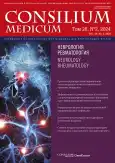Progressive multifocal leukoencephalopathy in the clinical practice of a neurologist. Case report
- Authors: Belova Y.A.1, Kotov S.V.1
-
Affiliations:
- Vladimirsky Moscow Regional Research Clinical Institute
- Issue: Vol 26, No 2 (2024): Neurology and rheumatology
- Pages: 88-92
- Section: Articles
- URL: https://journals.rcsi.science/2075-1753/article/view/256850
- DOI: https://doi.org/10.26442/20751753.2024.2.202673
- ID: 256850
Cite item
Full Text
Abstract
Progressive multifocal leukoencephalopathy (PML) is an opportunistic infection with severe brain damage caused by the JC-virus, against the background of immunosuppressive conditions. The diagnosis of PML is complex and includes: the clinical picture, neuroimaging data, the presence of JC-virus DNA in samples of cerebrospinal fluid or brain tissue. HIV-associated PML is difficult to diagnose. In patients with multiple sclerosis, an increase in the incidence of PML is associated with the use of natalizumab. Increasing alertness towards the development and detection of PML makes it possible to achieve a favorable outcome.
Full Text
##article.viewOnOriginalSite##About the authors
Yuliana A. Belova
Vladimirsky Moscow Regional Research Clinical Institute
Email: kotovsv@yandex.ru
ORCID iD: 0000-0003-1509-9608
Cand. Sci. (Med.)
Russian Federation, MoscowSergey V. Kotov
Vladimirsky Moscow Regional Research Clinical Institute
Author for correspondence.
Email: kotovsv@yandex.ru
ORCID iD: 0000-0002-8706-7317
D. Sci. (Med.), Prof.
Russian Federation, MoscowReferences
- Захарова М.Н. Прогрессирующая мультифокальная лейкоэнцефалопатия (обзор литературы). Журнал неврологии и психиатрии им. С.С. Корсакова. 2012;112(92):29-33 [Zakharova MN. Progressive multifocal leukoencephalopathy (review). Zhurnal Nevrologii i Psikhiatrii im. SS Korsakova. 2012;112(92):29-33 (in Russian)].
- Конькова-Рейдман А.Б., Михеева Т.В., Вексей А.А., и др. Анализ случаев прогрессирующей мультифокальной лейкоэнцефалопатии у больных ВИЧ-инфекцией: клинико-эпидемио- логические, диагностические и терапевтические аспекты проблемы. ВИЧ-инфекция и иммуносупрессии. 2020;12(4):81-6 [Konkova-Reidman AB, Mikheeva TV, Veksey AA, et al. Аnalysis of cases of progressive multifocal leukethephalopathy in patients with HIV infection: clinical, epidemiological, diagnostic and therapeutic aspects of the problem. HIV Infection and Immunosuppressive Disorders. 2020;12(4):81-6 (in Russian)]. doi: 10.22328/2077-9828-2020-12-4-81-86
- Cortese I, Muranski P, Enose-Akahata Y, et al. Pembrolizumab treatment for progressive multifocal leukoencephalopathy. N Engl J Med. 2019;380(17):1597-605. doi: 10.1056/NEJMoa1815039
- Lambert N, El Moussaoui M, Maquet P. Immune checkpoint inhibitors for progressive multifocal leukoencephalopathy: Identifying relevant outcome factors. Eur J Neurol. 2021;28(11):3814-9. doi: 10.1111/ene.15021
- Якушина Т.И., Якушин Д.М., Штанг И.О. Дифференциальная диагностика воспалительного синдрома восстановления иммунитета и прогрессирующей мультифокальной энцефалопатии при отмене натализумаба. Журнал неврологии и психиатрии им. С.С. Корсакова. 2023;123(3):11621 [Yakushina TI, Yakushin DM, Shtang IO. Differential diagnosis of immune reconstitution inflammatory syndrome and progressive multifocal leukoencephalopathy after natalizumab withdrawal. Zhurnal Nevrologii i Psikhiatrii im. SS Korsakova. 2023;123(3):11621 (in Russian)]. doi: 10.17116/jnevro2023123031116
- Самотолкина Е.А., Покровская А.В., Самотолкина Е.С., и др. Случай прогрессирующей многоочаговой лейкоэнцефалопатии у ВИЧ-инфицированной пациентки. Терапевтический архив. 2016;88(11):91-3 [Samotolkina EA, Pokrovskaia AV, Samotolkina ES, et al. A case of progressive multifocal leukoencephalopathy in a HIV-infected female patient. Terapevticheskii Arkhiv (Ter. Arkh.). 2016;88(11):91-3 (in Russian)]. doi: 10.17116/terarkh2016881191-93
- Martinez JV, Mazziotti JV, Efron ED, et al. Immune reconstruction inflammatory syndrome associated with PML in AIDS: a treatable disorder. Neurol. 2006;67:1692-4.
- Белова А.Н., Растеряева М.В., Жулина Н.И., и др. Воспалительный синдром восстановления иммунитета и ребаунд-синдром при отмене некоторых препаратов иммуномодулирующей терапии рассеянного склероза: общие представления и собственное наблюдение. Журнал неврологии и психиатрии им. С.С. Корсакова. 2017;117(22):7484 [Belova AN, Rasteryaeva MV, Zhulina NI, et al. Immune reconstitution inflammatory syndrome and rebound syndrome in multiple sclerosis patients who stopped disease modification therapy: current understanding and a case report. Zhurnal Nevrologii i Psikhiatrii im. SS Korsakova. 2017;117(22):7484 (in Russian)]. doi: 10.17116/jnevro20171172274-84
- Bag AK, Curéa JK, Chapman PR, et al. JC Virus Infection of the Brain. Am J Neuroradiol. 2010;31(9):1564-76. doi: 10.3174/ajnr.A2035
- Brück W, Gold R, Lund BT, et al. Therapeutic decisions in multiple sclerosis: moving beyond efficacy. JAMA Neurol. 2013;70(10):1315-24. doi: 10.1001/jamaneurol.2013.3510
- Warnke C, Olsson T, Hartung HP. PML: The Dark Side of Immunotherapy in Multiple Sclerosis. Trends Pharmacol Sci. 2015;36(12):799-801. doi: 10.1016/j.tips.2015.09.006
- Wysowski D, Bozic C. Natalizumab’s Risk Minimization action plan and risk management plan. Food and Drug administration’s peripheral and central nervous system drug advisory committee meeting. Gaithersburg. 2006.
- N’gbo N’gbo Ikazabo R, Mostosi C, Quivron B, et al. Immune-reconstitution Inflammatory Syndrome in Multiple Sclerosis Patients Treated With Natalizumab: A Series of 4 Cases. Clin Ther. 2016;38(3):670-5. doi: 10.1016/j.clinthera.2016.01.010
- Dong-Si T, Richman S, Wattjes MP, et al. Outcome and survival of asymptomatic PML in natalizumab-treated MS patients. Ann Clin Transl Neurol. 2014;1(10):755-64. doi: 10.1002/acn3.114
- Carrillo-Infante C, Richman S, Yu B, et al. Functional and survival outcomes of asymptomatic progressive multifocal leukoencephalopathy in natalizumab-treated multiple sclerosis patients: 2015 update. Mult Scler. 2016;22:798.
- Anadani N, Hyland M, Cruz RA, et al. Treating MS after surviving PML: Discrete strategies for rescue, remission, and recovery patient 1: From the National Multiple Sclerosis Society Case Conference Proceedings. Neurol Neuroimmunol Neuroinflamm. 2020;8(1):e929. doi: 10.1212/NXI.0000000000000929
- Maillart E, Louapre C, Lubetzki C, Papeix C. Fingolimod to treat severe multiple sclerosis after natalizumab-associated progressive multifocal leukoencephalopathy: a valid option? Mult Scler. 2014;20:505-9.
- Hoepner R, Faissner S, Ellrichmann G, et al. Rituximab post progressive multifocal leukoencephalopathy: a feasible therapeutic option in selected cases. Ther Adv Neurol Disord. 2014;7:289-91.
Supplementary files









